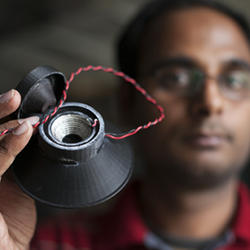
Almost every week, it seems, there is an announcement of new 3D-printed objects, from pizza for astronauts to replacement body parts. The technology, which uses digital control similar to that in home printers to build up complex three-dimensional objects point by point, is clearly versatile, but will it be the basis for a revolution in manufacturing, or is it just a passing fad?
"There’s a lot of questioning right now of whether 3D printing is hype" that will soon die away, says Hod Lipson, an associate professor of Mechanical & Aerospace Engineering and Computing & Information Science at Cornell University in Ithaca, NY. As co-author of Fabricated: The New World of 3D Printing, he is a clear believer in the technology. To further expand awareness of the technology’s capabilities, Lipson’s team recently printed a functional loudspeaker, comprising a plastic cone and shell, a coil of conductive wire, and a permanent magnet. (The wires connecting the speaker to a signal source were added later.)
"Everything we’ve seen with 3D printing up until today is mostly passive: passive parts made out of plastic, metal, and so forth," Lipson says. When 3D printing begins to combine disparate materials, especially if they include materials with functional roles, "it really unleashes a whole new design-space of things that we haven’t experienced before."
A major challenge in printing such a complex object is that different materials may require processes that are not compatible. In the speaker, for example, the wires of the coil are printed with a metal-containing ink that must be heated to make it conduct electricity well, but too high a temperature would destroy the plastic parts. Lipson’s team had to choose conditions that balanced these conflicting requirements.
In this case, the team used two printers based on the open source Fab@Home design that Lipson helped establish. "It’s not a great speaker. It’s not particularly cheap. It’s not quick to make," says Lipson, as printing the parts took several hours. "It’s not better-sounding" than a speaker made through standard manufacturing methods, "but it’s a demonstration."
An object like a speaker, which can be cheaply mass-produced using traditional techniques, is also not an obvious winner for 3D printing, which is most powerful for making unique objects in small numbers. "It is mostly going to contribute in the area of customized product prototyping," says Apoorva Kiran who, with fellow graduate student Robert MacCurdy, implemented the loudspeaker project in Lipson’s group.
The technology is cheap and easy enough that it has inspired a whole subculture of hobbyists known as "makers." Enthusiasts imagine it becoming as ubiquitous as inkjet printers, driven by companies like MakerBot and the open-source Fab@Home. However, "We don’t need printers in every home for the technology to be successful. We can envision having local fabrication centers that serve a community or region," perhaps similar to local copy and printing centers, says MacCurdy.
In addition to material-processing challenges, the speaker project reveals limitations in currently available software tools, Lipson says. "This particular example is a very simple device. We could sort of design it in our heads," while more complex designs that combine multiple materials will need better tools to let designers predict their electrical and mechanical properties. "Right now, the manufacturing process is a few generations ahead of the design tools," Lipson says. "It’s a bit of a chicken-and-egg problem," because software companies will be reluctant to develop such products until examples of complex designs become widespread.
Although the speaker project is "great," the tools do "have a little ways to go," acknowledges Jesse Harrington Au, a designated advocate for makers at the design-software company Autodesk. "You are seeing a need to bring those programs together" to provide a comprehensive design and simulation environment, and Autodesk recently augmented its tools for circuit simulation. Comprehensive processing and simulation tools have long been available for traditional semiconductor manufacturing, as well as for micro-electromechanical systems (MEMS), Lipson, says, but they do not take advantage of the capability of 3D printing to create essentially arbitrary shapes.
Yet "makers" are not the only believers in 3D printing, also known as "additive manufacturing," which allows greater flexibility in optimizing shapes and in efficiently using rare and expensive materials. General Electric, for example, has described plans to use the process to make parts for its aircraft engines. "The future’s really bright," says Au.
Don Monroe is a science and technology writer based in Murray Hill, NJ.



Join the Discussion (0)
Become a Member or Sign In to Post a Comment